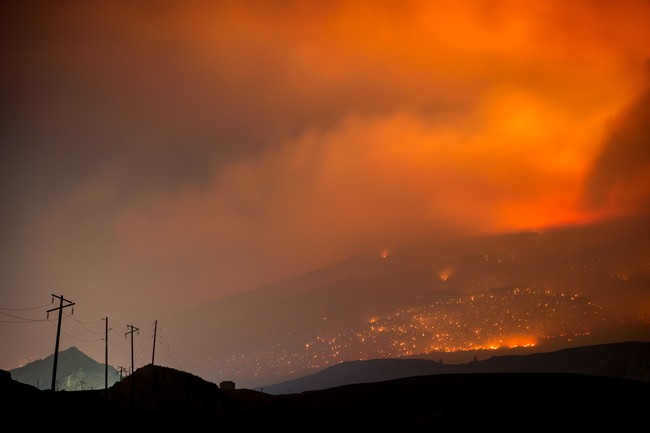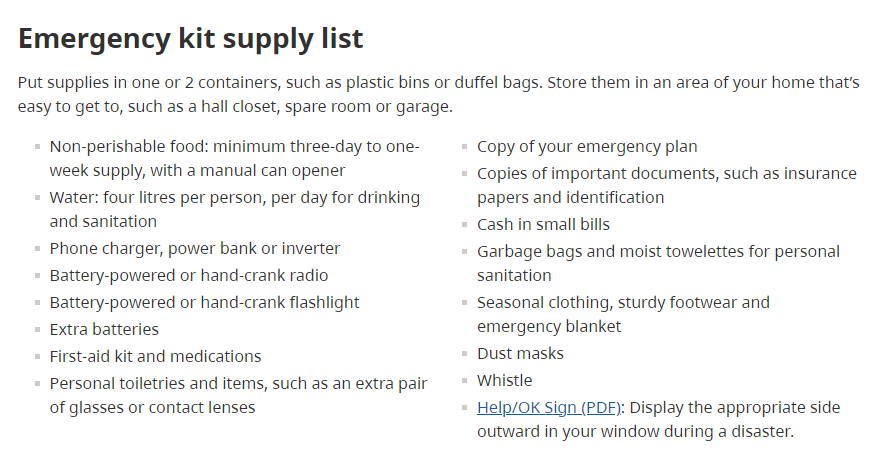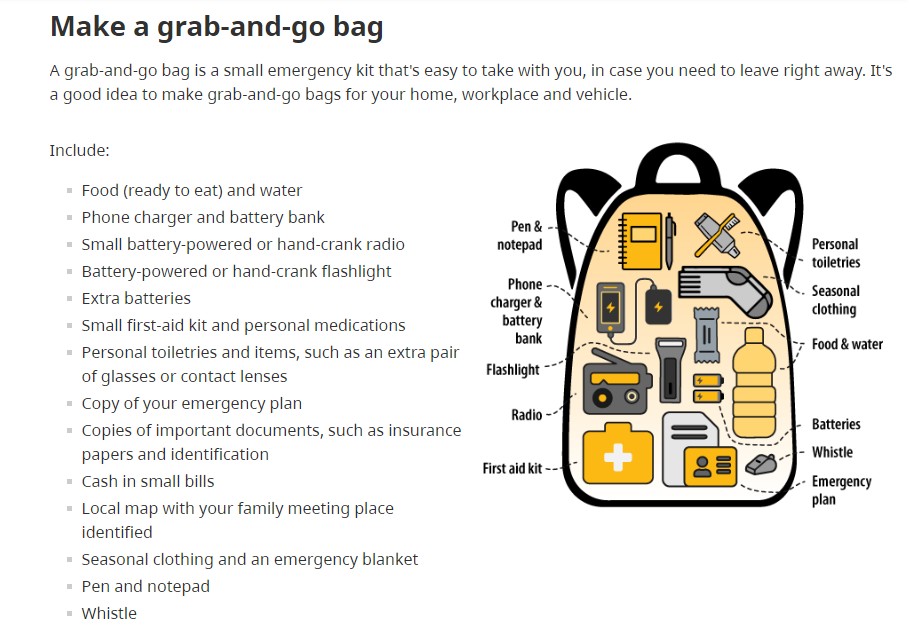Do you have an emergency grab-and-go bag? How about an emergency plan? Do you know what to do if you find yourself facing an evacuation order?

With wildfire and flood risks rising across British Columbia — and expected to grow in frequency and intensity due to climate change — those are questions emergency officials want you to ask yourself.
And while fires and floods may be the primary threat today, preparing properly can help arm you with the tools you need in the face of any disaster.
“If you prepare for an earthquake, you’re prepared for anything — the basic concept there is that the steps you take to prepare for one hazard are largely transferable to other hazards that are also important to prepare for wherever you are in B.C.,” explained Ryan Turcot, public education officer with B.C.’s Ministry of Emergency Management and Climate Readiness.
“Obviously wildfires are a little bit more common in the Southern Interior, as opposed to Vancouver Island, for example, where earthquakes and tsunamis might be more more applicable to in top of mind for a lot of folks — but whether you are preparing to evacuate because it was tsunami or because of a wildfire in the Interior, that same grab-and-go-bag is going to have all the same supplies that you need to take with you on short notice.”
Be ready ahead of time
Getting through an emergency situation is never easy, but preparing ahead of time can go a long way towards ensuring you stay safe and reducing stress.
That starts with creating an emergency plan, and ensuring you have the right supplies on hand when disaster strikes.
Turcot said a good emergency plan should include a list of emergency contacts — both nearby and out of the area — and an emergency meeting place for your family.

It should also include insurance and medical information, pet information, work and school contact information and pickup plans and utility details.
You can download a fill-in-the-blanks emergency plan from Emergency Management BC.
Along with an emergency plan, British Columbians should have emergency supplies in an easily accessible place in their homes.
“We encourage folks to pack both a stay-at-home emergency kit as well as a grab-and-go bag. They’re related concepts, but stay-at-home emergency kit … it would be a larger kit of emergency supplies that will allow you to (be) self-sustaining for three days to up to two weeks time,” Turcot explained.
“On the other hand, a grab-and-go bag is basically a smaller version of your emergency kit that is basically whatever supplies that you can fit into portable bags like backpacks or duffel bags, and basically it’s just going to contain enough supplies that you can take with you quickly if you have to evacuate on short notice.”

Crucial items to include in your grab-and-go bag include non-perishable food and water, a small battery-powered or hand-cranked radio, a flashlight, spare batteries, a first-aid kit, personal toiletries, medications and glasses or contact lenses, key documents, identification and cash in small bills.

Get daily National news
It should also include seasonal clothing, pet supplies if needed, a pen and notepad, and a mobile phone charger.
As of this year, British Columbians can also get ahead of a disaster by pre-registering with Emergency Support Services online, which can make it easier to access supports in the event of an evacuation.
Turcot said that involves downloading the B.C. Services Card app, where they can register all members of their household online.
On top of their emergency plans and supplies, British Columbians can also prepare for emergency situations by knowing where to turn to get timely updates about what is happening in their area.
“You want to know where are your local sources of information are going to be coming from in the event of an evacuation alert or order,” Turcot said. “That will typically be your your regional district, your municipality, or your local First Nation.”

What do do in an evacuation alert
British Columbia municipalities, regional districts and First Nations will issue an evacuation alert when they determine a community may be at risk due to an approaching threat.
If you receive an alert, it means it’s time to get your emergency supplies ready and be prepared to leave on a moment’s notice.
“First and foremost, you want to follow all the instructions that your local authority or First Nation has provided for you,” Turcot said.
“Once you … receive an evacuation alert, you want to definitely make sure that your grab-and-go bags are packed and ready to go.”

If time allows, you should ensure you’ve got at least half a tank of fuel in your vehicle, and park it in a way that’s easy to leave quickly.
Turcot also said there are specific steps people can take to prepare for different hazards.
In a wildfire situation, that could include moving patio furniture and other flammable materials indoors, removing flammable curtains and window treatments, and filling up pools, hot tubs or large containers with water that can help firefighters.
In the case of a flood, it could include moving vehicles away from waterways and removing toxic substances like pesticides from flood-prone areas and using sandbags to block floor drains and toilets to prevent sewage backup.
By contrast, Turcot people facing flood alerts should not try and turn off their electricity due to the risk of electrocution if there is water near their property.

People under an evacuation alert should also take a moment to familiarize themselves with the emergency situation in their region, and continue to follow local media.
EmergencyInfoBC has an interactive map with a list of current emergencies, along with evacuation alerts and orders.
Know the road conditions. Motorists are advised to monitor the DriveBC website and Twitter account for the latest on closures and detours.
You can also find trusted information through the BC Wildfire Service’s website and Twitter account, and EmergencyInfoBC’s website and Twitter account.
What to do under an evacuation order
Officials will issue an evacuation order if an emergency escalates to put residents in immediate risk.
“If you receive an evacuation order, you’re in immediate danger and need to leave the area,” Turcot said.
“It’s very important to heed all of the instructions that your local authorities or First Nation has specified on that evacuation order, which will typically include instructions on the address and evacuation route to get to an emergency evacuation reception center.”
This is the time to load your grab-and-go bag and leave, as you may only have minutes to leave.

If there is time, Turcot said it’s a good idea to close doors and windows and turn on indoor and outdoor lights so firefighters can see the property if there is heavy smoke.
However, evacuees should not lock their gates, so emergency crews can access the property if necessary.
Evacuees should wear sturdy shoes, long-sleeved shirts and pants to protect against hazards, and follow evacuation routes specified by emergency officials. Avoid shortcuts, which could take you into danger.
Once they have travelled to a safe location, evacuees can register with Emergency Support Services if they haven’t already in order to access funds or other supports for food, lodging or clothing.
If you are going to an evacuation centre, register when you arrive so people can contact you and you can be reunited with friends or family.
“That’s also a good time to look at your emergency contacts in your your home emergency plan and reach out to any family or friends that might be wondering about your safety and let them know you’ve made it and you’re safe,” Turcot said.
Evacuees should then wait for local officials to issue the all-clear about when they can return home and should monitor local media and official social media accounts for updates.










Comments